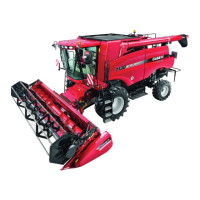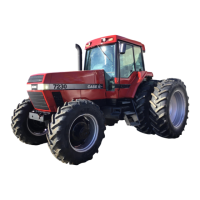6 - FIELD OPERATION
229
Separator Losses
This is loss from the rotor and cleaning system such
as unthreshed heads, etc. which are a result of
improper adjustments or lack of proper attachments.
To obtain this loss, check Area “C” which is
windrowed directly behind the separator. The grain in
this area would be all losses. Subtract the preharvest
(Area “A”) and the header losses (Area “B”) from this
measurement to determine the separator loss. For a
more precise measurement, refer to the Seed Loss
Tables to obtain the amount of loss in bushels or
pounds per acre for your machine.
Before making adjustments, make sure there are no
grain leaks due to missing bolts, clean out doors
open, etc. If separator loss is high, it is necessary to
determine whether the loss is from the rotor or
cleaning system.
To determine whether the separator loss is due to the
rotor or cleaning system, fully open the shoe and
chaffer sieve.
NOTE: This procedure will cause a poor sample due
to excessive trash in the grain sample during the test.
If separator loss remains high it is due to rotor losses.
If separator loss decreases the loss is due to
improper cleaning system adjustments.
Sieve settings are essentially the same with an
AXIAL-FLOW® Combine as in the past with
conventional Combines. Too heavy tailings could
result in rotor losses.
There are three basic adjustments for the cleaning
system. These are (1) opening and closing the
chaffer; (2) opening and closing the shoe and (3)
cleaning fan rpm changes. The main air blast is
directed to the front part of the chaffer. Air speed
should be sufficient to lift material and suspend it in
the air, letting heavier particles (grain) down. If
underblown, material will ride on the chaffer and
grain will be sloughed off the end of the chaffer. If
overblown grain will be picked up and blown beyond
the end of the chaffer.
The need for cleaning shoe adjustments can be
easily determined by monitoring grain tank samples,
tailings and losses on the ground. If tailings are
excessive, open the shoe slightly. If grain tank
sample is trashy, close the shoe and/or increase the
fan speed. Too wide of a chaffer sieve opening can
add to excessive tailings. Tailings can be monitored
with the Tailings Monitor, Watch Your Monitor.
An overloaded shoe sieve and high tailings can also
be the result of too low fan speed setting instead of
too open chaffer setting. It is important to remember
that the air velocity through the chaffer sieve will
change by changing the sieve opening (with constant
fan speed). Therefore the more the chaffer sieve is
opened the faster the fan speed should be set in
order to continue to lift the lighter chaff material and
blow it out the rear. This is handy to remember when
more capacity is desired from the cleaning system.
With the introduction of the Cross Flow® fan to the
cleaning system, improved air flow uniformity has
allowed the fan to be operated at higher speeds
without concern for blowing grain out the back.
Consult the tables for suggested fan speeds.
For side hill operations, chaffer dividers are available.

